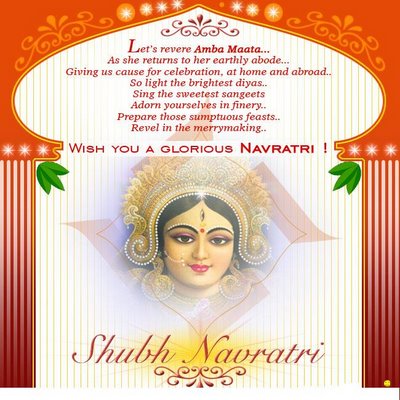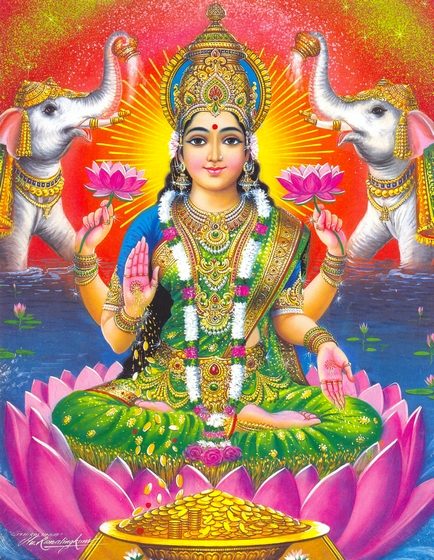Navadurga – Nine Forms of Goddess Durga
Worshiped During Navratri
Navadurga, or Navdurga, are the nine forms of Durga collectively worshipped by Shakti devotees. Scriptures differ in naming the nine incarnations. Pictures and paintings of the Nava-Durga also varies from region to region. The most widely accepted account of the nine forms of Durga is the one found in the Devi Mahatmya – Sailaputri, Brahmacharini, Chandraghanta, Kushmanda, Skanda Mata, Katyayani, Kalaratri, Maha Gowri and Siddhidayini. The nine forms of Durga are worshipped during the nine days of Navratri.
 Sailaputri or Shailaputri – In this form Durga is two-armed and carries a trident and lotus. Her mount is an ox or bull. Sailaputri is believed to be the rebirth of Sati, the daughter of Daksha and the wife of Lord Shiva. In her second birth she is Parvati, the daughter of
Sailaputri or Shailaputri – In this form Durga is two-armed and carries a trident and lotus. Her mount is an ox or bull. Sailaputri is believed to be the rebirth of Sati, the daughter of Daksha and the wife of Lord Shiva. In her second birth she is Parvati, the daughter of  Brahmacharini – In this form Durga is two-armed and carries a rosary and sacred water pot (Kamandalu). She is in a highly pious and peaceful form or is in meditation. This form of Durga is related to the severe penance undertaken by Sati and Parvati in their respective births to attain Lord Shiva as husband. Some of the most important Vratas observed in different parts of
Brahmacharini – In this form Durga is two-armed and carries a rosary and sacred water pot (Kamandalu). She is in a highly pious and peaceful form or is in meditation. This form of Durga is related to the severe penance undertaken by Sati and Parvati in their respective births to attain Lord Shiva as husband. Some of the most important Vratas observed in different parts of
Chandraghanta or Chandra-khanda – In this form Durga is 10-armed and rides a tiger. She carries pot, bow, arrow, lotus, discus, rosary, trident, mace and sword. This is a terrible aspect and is roaring in anger. This form of Durga is completely different from earlier forms and shows when provoked she can be the terrible or malevolent. Chandraghanta is worshipped on the third day of Navarathri.
 Kushmanda – In this form Durga is eight-armed and rides on a tiger. She holds kamandalu, bow, arrow, lotus, pot containing wine, disc, rosary and a club. She is very happy in this form and it is believed that the eternal darkness ended when she smiled. And this led to the beginning of creation. Kushmanda form of Durga is worshipped on fourth day of Navratri.
Kushmanda – In this form Durga is eight-armed and rides on a tiger. She holds kamandalu, bow, arrow, lotus, pot containing wine, disc, rosary and a club. She is very happy in this form and it is believed that the eternal darkness ended when she smiled. And this led to the beginning of creation. Kushmanda form of Durga is worshipped on fourth day of Navratri.
In this form Durga is four-armed and rides on a lion. She carries lotus, kamandalu (pot) and bell. Her one hand is in blessing posture. In this form she is the mother of Lord Muruga or Subrahamniya or Kartik, who is also known as Skanda. This the motherly form of Durga and she is benevolent. Skanda Mata form of Durga is worshipped on the fifth day of Navaratri.
 Katyayani – In this form Durga is four-armed and she carries a sword, shield and lotus. One hand is depicted as giving blessing. She rides a lion. It is believed that in this form she was born as a daughter to Sage Katya of Katya clan. This is the daughter form of Durga. She is epitome of love also won’t hesitate to rise up in anger. Katyayani form of Durga is worshipped on the sixth day of Navrathri.
Katyayani – In this form Durga is four-armed and she carries a sword, shield and lotus. One hand is depicted as giving blessing. She rides a lion. It is believed that in this form she was born as a daughter to Sage Katya of Katya clan. This is the daughter form of Durga. She is epitome of love also won’t hesitate to rise up in anger. Katyayani form of Durga is worshipped on the sixth day of Navrathri. Kalaratri– In this form Durga is four-armed and rides a donkey. She carries sword, trident and noose. With one hand she blesses. In this form she is dark and repulsive in appearance. She is cruel and excited. This is the violent and dark side of Durga. This form primarily depicts that life also has dark side. Kalaratri form of Durga is worshipped on seventh day of Navarathri.
Kalaratri– In this form Durga is four-armed and rides a donkey. She carries sword, trident and noose. With one hand she blesses. In this form she is dark and repulsive in appearance. She is cruel and excited. This is the violent and dark side of Durga. This form primarily depicts that life also has dark side. Kalaratri form of Durga is worshipped on seventh day of Navarathri. Mahagauri or Maha Gowri – In this form Durga is four-armed and she rides on a bull or a white elephant. She carries a trident and hand-drum. Two hands are in blessing posture. She is pure and is believed to have been in the form of Mata Parvati when she did penance to get Shiva as her husband. Purity is depicted in this form of Durga. Mahagowri form of Durga is worshipped on the eighth day of Navratri.
Mahagauri or Maha Gowri – In this form Durga is four-armed and she rides on a bull or a white elephant. She carries a trident and hand-drum. Two hands are in blessing posture. She is pure and is believed to have been in the form of Mata Parvati when she did penance to get Shiva as her husband. Purity is depicted in this form of Durga. Mahagowri form of Durga is worshipped on the eighth day of Navratri. Siddhidayini or Siddhidatri – In this form Durga is seated on a lotus and is four armed. She holds a lotus, mace, discus and book. In this form Durga removes ignorance and she provides the knowledge to realize That or Brahman. She is surrounded by Siddhas, Gandharvas, Yakshas, Demons and Gods who are worshipping her. The Siddhi that she provides is the realization that only She exists. Siddhidayini form of Durga is worshipped on the ninth day of Navaratri.
Siddhidayini or Siddhidatri – In this form Durga is seated on a lotus and is four armed. She holds a lotus, mace, discus and book. In this form Durga removes ignorance and she provides the knowledge to realize That or Brahman. She is surrounded by Siddhas, Gandharvas, Yakshas, Demons and Gods who are worshipping her. The Siddhi that she provides is the realization that only She exists. Siddhidayini form of Durga is worshipped on the ninth day of Navaratri.
===============
REPRODUCED FROM E-MAIL --
We think this energy is only a form of the Divine Mother, who is the mother of all, and all of us are her children. "Why mother; why not father?", you may ask. Let me just say that we believe that God's glory, his cosmic energy, his greatness and supremacy can best be depicted as the motherhood aspect of God. Just as a child finds all these qualities in his or her mother, similarly, all of us look upon God as mother. In fact, Hinduism is the only religion in the world, which gives so much importance to the mother aspect of God because we believe that mother is the creative aspect of the absolute.
Why Twice a Year?
Every year the beginning of summer and the beginning of winter are two very important junctures of climatic change and solar influence. These two junctions have been chosen as the sacred opportunities for the worship of the divine power because:
(1) We believe that it is the divine power that provides energy for the earth to move around the sun, causing the changes in the outer nature and that this divine power must be thanked for maintaining the correct balance of the universe.
(2) Due to the changes in the nature, the bodies and minds of people undergo a considerable change, and hence, we worship the divine power to bestow upon all of us enough potent powers to maintain our physical and mental balance.
Why Nine Nights & Days?
Navaratri is divided into sets of three days to adore different aspects of the supreme goddess. Navaraathri is the nine nights that is observed in honour of the divine mother in her three forms as Durga, Lakshmi and Saraswathi. On the first three days, the Mother is invoked as powerful force called Durga in order to destroy all our impurities, vices and defects. The next three days, the Mother is adored as a giver of spiritual wealth, Lakshmi, who is considered to have the power of bestowing on her devotees the inexhaustible wealth. The final set of three days is spent in worshipping the mother as the goddess of wisdom, Saraswati. In order have all-round success in life, we need the blessings of all three aspects of the divine mother; hence, the worship for nine nights.
FIRST THREE DAYS DURGA:









No comments:
Post a Comment